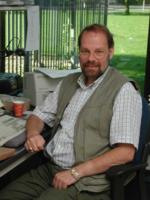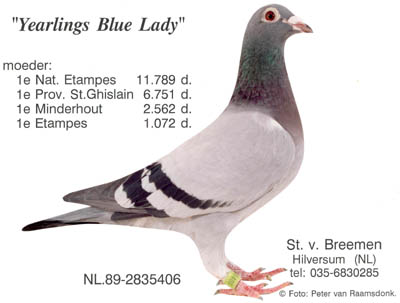Part 12
The wing

The wing of the pigeon was the source of a terrible paper war between article writers and fanciers. This was caused in the first place because an otherwise excellent Belgian author, Charles Vanderschelden, developed and published his ideas about the best wing form. It boiled down that one could only separate the best from the worst pigeons on the basis of this feature. The avalanche of discussion is already over, but it delivered a double dose of notoriety in the history of the pigeon sport to Vanderschelden. It is absolutely clear that his ideas about wing form are current and good. The only mistake he made was that, by a long shot, you cannot pick the best pigeon on the basis of wing form alone. Because the wing form is only a means, but covers by no means the essence of the performance capacity. When I wrote my proposal for improvement of the international standard years ago, I formulated this subject as follows:

"Yearlings Blue Lady" was bred out of "De Goede Jaarling" and "De 776 Duif". This mating was to concentrate the golden bloodline of "De 08 Duif". With 5 different cock's she bred winners. Her best son won in 1996 the 1th National Etampes. Her full brother is "De Bonte Jaarling" also a super breeder. The hen to produce the 2nd National Ace Young '98 for Mr. Willem de Bruijn of Reeuwijk is a direct daughter.
"The role of the wings with the performance capacity of racing pigeons is more or less the same as the man holding a shovel in his hand. A ditch digger with the same shovel will be able to move three times as much earth in two hours than for example a bureaucrat. The same applies for the wing. There are better and weaker shovels, but the essence is always the same, it depends WHO shovels".
I already wrote earlier that, in my opinion, the performance capacity is formed by intelligence and the mordant. The vitality, the equilibrium of the body, the muscle quality, the plumage or the wing form do improve or diminish performance to a certain extend. The wing shape, best able to improve the performance capacity -principally speed- is in no way the old-fashioned, broad shovel formed, but somewhat longer, smaller wing type. Such pigeons are usually open on the back and their "trouser pins" are shorter. Wilhelm Scheer I mentioned earlier is of the opinion: "When someone shows me several good pigeons for the purpose of selecting the fastest, I usually look at them from above. And I point to the pigeons who's back is completely open. And I'm seldom mistaken". So far Scheer. There is something in that but not everything. I underlined the word "good" in this statement. That is the essence of the matter! In the case of listing good pigeons according to rank, there is something in it. But a pigeon with, for example stiff, bad muscles will never become a champion on account of an ideal wing.
At the same time one meets many good racers with small or short wing surfaces. Vanderschelden was off the mark when he was handed a cock for evaluation. He saw that the pigeon had a very short wing. On this he based his judgment: slaughter! One told him later on that this pigeon had been the best flyer of Belgium in that year. It was "De Jonge Stier" of André Van Bruane! I can still give more of such examples. Most Delbars also have short wings. I believe to be not far off in saying that the productive use of diverse wing forms is closely connected with weather conditions. The big shovel wing has an advantage on a race with tailwind (speed 1500 mpm) because the wind easily drives such a wing ahead. The modern, fast wings are not an immediate advantage with strong head winds because the outer big quill feathers are being turned in the wind and often so far that finally the pigeon is unable to fly. Short wings are better with such a wind because the last big quill feathers are shorter and therefore more stable.
Out of this we draw the conclusion that in evaluating racing capacity according to wing form, we must be careful and that it would be wrong to select on this basis. Next, let's look at the -definitely right- Vanderschelden theory:
The under arm (up to arm pit) is maximum 6 cm long and in any case thick. A thin longer under arm has less resistance. The "trouser pins" must be maximum 11-11,5 cm long with hens, with cocks up to 12 cm. A rear wing with long trouser pins which make the wing look broad characterize slow pigeons. Careful attention must be paid to the outer four quill feathers regarding their lengths and form. The numbering of the feathers is usually in the order of the shedding. Therefore in this order the first is always the inner one and so it adds up to the outer edge of the wing. Vanderschelden has established that their length is between 12-15 cm. The outer feathers must be as long as possible in his opinion. Their form must resemble a well sharpened bread knife -not too wide- so that the pigeon can adjust to air fluctuations to better utilize possible air currents. The outer gathers must "ventilate", that is to say when we open a wing, the feathers must not show a completely closed mass, but give the impression that peas can fall through in the area of the outer edges. Vanderschelden was always worried about the form of the feathers. He mentions four variations:
1. The eighth is shorter, the ninth longer, the tenth longest. He considers this to be a bad wing;
2. The eighth is shorter, the ninth is the longest and the tenth again somewhat shorter.
These pigeons are of average quality. We find a lot of waste among them and they don't have breeding value (not that anybody believes this!);
3. The seventh is significantly shorter, but the eighth, the ninth and the tenth are of equal length. According to Vanderschelden, one finds many first prize winners among those and one may breed out of them;
4. The seventh feather is just as long as the eighth, the ninth and the tenth. The last four feathers are therefore more or less of equal length. There is a significant difference in length between the sixth and the seventh. He considers those to be the super favorites for breeding as well for racing.
No doubt the above order from an aerodynamic point of view is good. However, one should not lose sight that the pigeon's capacity is not being formed by the wing shape, but that is only an aid or an handicap. That's why the combination wing shape = breeding value is absurd. But apart from that we can positively accept Vanderschelden's opinion about favorable wing shape or form.
I would like to add that it is worthwhile to review the feather quality. In the first place, one can see from the quills of the feathers whether they are elastic, strong and flexible, or fragile, dry and weak. In any case, the tips of the feathers must be rounded also with the last four instead of having a pointed form. On the quills of the feathers we can often find small cracks. The more we find those, the more we can be convinced that in one way or the other the pigeon was heavily laden during the development of these feathers. That could have been an illness, or a heavy race, a long roaming about another reason. When this is noticed with a pigeon who had no reason, one can almost be sure that such a specimen has a weak construction. I have had youngsters who, by an inadequate development had such cracks the first moulting, or tail feathers with a water mark.
The reason for these bad quality feathers was their parents neglect. But after weaning, they developed normally, lost their feathers with the water mark and subsequently their inherited quality developed.
Steven van Breemen
Copyright 1998. All rights reserved. Reproduction in whole, in part, in any form or medium, without the express written permission of Steven van Breemen, is forbidden.
The whole book can be downloaded from "Winning Magazine" if you are a subscriber. You can subscribe here; costs 35 Euro for 1 year. You get 26 issues and have access to the archives with all previous published issues plus next to "The Art of Breeding" a second book written by me: "Hints for Mating, Breeding & Selection". A total bargain!
| 
